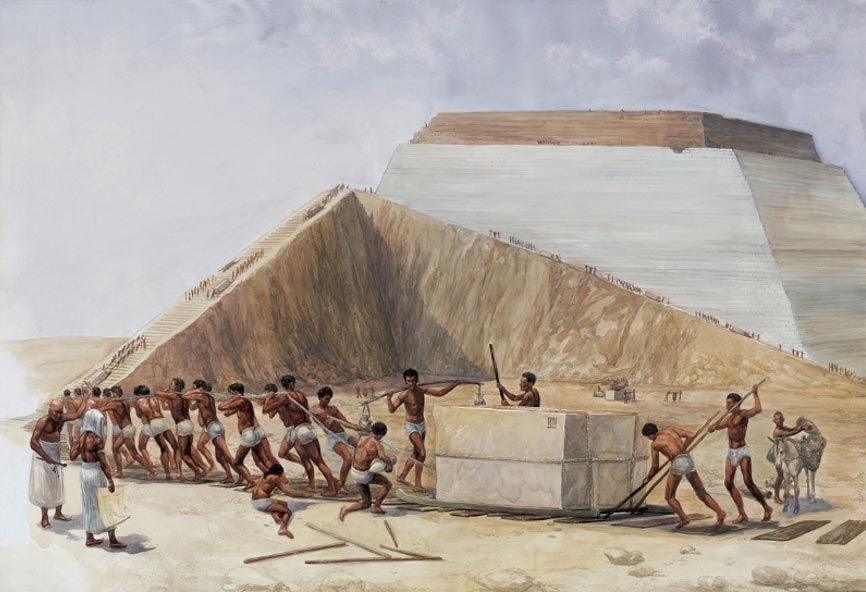10 Interesting Facts about Ancient Egyptian Pyramids
- MAI

- Jun 25, 2018
- 4 min read
Updated: Jul 1, 2020
Iconic and mesmerising as they are, the Egyptian Pyramids have managed to find a place in my heart. It was a privilege to go inside and explore the most legendary pyramids, the Pyramids of Giza. This consisted of three large pyramids constructed for the pharaohs Khufu, Khafre, and Menkaure built between 2589 BC and 2504 BC.
Pharaohs used pyramids as tombs for themselves (where their dead bodies were preserved through mummification, though no mummy of a pharaoh has been found within a pyramid), their family members, their slaves, their treasures like jewellery (as well as day-to-day items in the hopes that they would be reunited with these items in the afterlife), and so on. Here's 10 interesting facts about Ancient Egyptian Pyramids.
1. Attempts to Destroy the Pyramids
A 12th century Kurdish ruler, King Al-Aziz (the second Ayyubid Sultan of Egypt and the son of Saladin Ayyubi) attempted to demolish the Giza Pyramids but was only able to damage Menkaure's Pyramid by creating a vertical hole on its north face before realising the magnitude of the task was too great to complete. As a result, the Great Pyramid of Giza, the oldest (and only existing) of the Seven Wonders of the Ancient World which was built 4500 years ago, survived attempts to destroy it and remained the tallest man-made building for over 3800 years.

2. Construction of the Pyramids
Allegedly, the Pyramids were specifically constructed to be aligned with the constellation of three stars of the Orion belt and even point directly towards Orion's belt. This holds symbolic significance as the stars of Orion are connected to the God of rebirth and afterlife, Osiris, according to Ancient Egyptians.

3. Slaves or Workers?
Pyramids were built by regular paid workers, not slaves or prisoners. In 2010, workers tombs were discovered in tombs as well.

4. Centre of the Earth
It can be argued that the Great Pyramid is located at the exact centre of all landmass on Earth; in 1877, Dr. Joseph Seiss found that the pyramid was positioned at the intersection of the longest line of longitude and of latitude.

5. Facing True North
The polar star 'Alpha Draconis' aligns with Earth once every 25,920 years; it came in alignment in 2141 BC when the Great Pyramid of Giza was constructed and was used by the architect to determine the direction of true north. It is the most accurately aligned structure facing true north. It was allegedly exactly aligned at one time but the position of the North Pole adjusts overtime so that it now has a minimal 3/60th of a degree of error.

6. The Pyramids and Calculations
The perimeter of the base of the Great Pyramid of Giza represents the amount of days in the year: the perimeter divided by 100 = 365.24.

7. The 'Glorious Light' of the Pyramids
'Pyra' in Greek means fire, light, or visible and 'midos' means measures; this composition of the word 'pyramid' is significant because the surfaces reflected heat, sunlight and moonlight, thus could aid Nile river navigation at night. Additionally, the casting stones that the pyramids were originally built with were made of highly polished white limestone; this allowed the stones to reflect the sun's light which made the pyramids shine so brightly that they could be seen from the mountains in Israel and the moon. Subsequently, the Ancient Egyptians called the Great Pyramid "Ikhet" meaning 'Glorious Light' because it shone like a star. Overtime, the stones were removed after a 14th century earthquake as well as Arabs removing them to use for the construction of mosques.

8. Pathway to the Kingdom of the Dead
Ancient Egyptian pyramids are located on the west bank of the River Nile due to the fact that they considered it to be the pathway to the kingdom of the dead (as the sun sets to the west).

9. The 8 Sides of the Great Pyramid
The Great Pyramid has 8 sides as each of the 4 sides have an indentation which cannot be seen from the ground and can only see it from an aerial view during autumn equinox and spring equinox during dawn and sunset as the sun casts a shadow on the pyramid. The curvature of the concave faces is the exact same as the earth's curvature.

10. The Grand Entrance to the Great Pyramid
The Great Pyramid had a swivel door that remained undetected from the outside due to it's perfect dimensions but was light enough to push open with your hand though it weighed 20 tons. It no longer exists but was discovered when the pyramid was broken into for the first time.

References:
Petr H. (August 25, 2017). 25 Fascinating Facts About Egyptian Pyramids You May Not Know, List 25, Geography and Travel
Vyas K. (February 25, 2018). Explore 33 Interesting Facts about the Ancient Egyptian Pyramids, Interesting Engineering, Culture/Inspiration
Sen, N. (September 6, 2012). Amazing Facts about the Great Pyramids of Giza, Live Science, Culture
Shay, N. (June 2, 2017). 10 Facts About The Pyramids That Could Prove Advanced Ancient Technology, List Verse, Facts
Baidya, S. (December 1, 2015). Great Pyramid of Giza - 60 Interesting Facts To Blow Your Mind!, Facts Legend, History





Comments